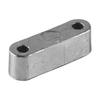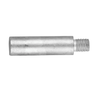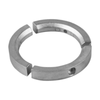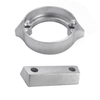
The risk with unprotected metal structures in harbors.
Leaving the harbor's sheet piling unprotected can lead to dangerous conditions and costly repairs. Especially in harbors where much of the infrastructure often consists of steel, the risk of corrosion is high. This can easily be prevented by installing cathodic corrosion protection. Cathodic corrosion protection uses sacrificial anodes that corrode instead of the more valuable metal components in the harbor, providing effective protection and extending the lifespan of the construction. This type of protection is not only economically beneficial due to reduced repairs and maintenance but also increases safety and reduces the need for frequent maintenance efforts.
Sometimes, certain areas with brackish water and high electrical resistance may require specially designed solutions. In these cases, systems with impressed current can be more effective than traditional sacrificial anodes.
Long-term effects and savings with corrosion protection
By proactively installing and maintaining cathodic corrosion protection in harbors, it is guaranteed that these critical infrastructure elements remain operational and safe for a long time, resulting in significant savings in both time and money. Anodes help to protect important metal constructions in harbors from rusting and being destroyed. They work by corroding themselves, or rusting, instead of the other metals around. This is called galvanic corrosion protection and is a way to extend the lifespan of the metal structures in the harbor.
The number of anodes needed in a harbor varies. It depends on how large the harbor is and how susceptible it is to corrosion. The anodes are placed at the locations where there is the highest risk of corrosion, often about 0.3 - 0.5 meters below the mean waterline. This ensures that they protect as effectively as possible. A significant advantage is also often that the depth of any crown beams can be reduced since the sacrificial anodes actively counteract the corrosion. This often results in substantial savings in money, time, and the environment.






























































Leave a comment